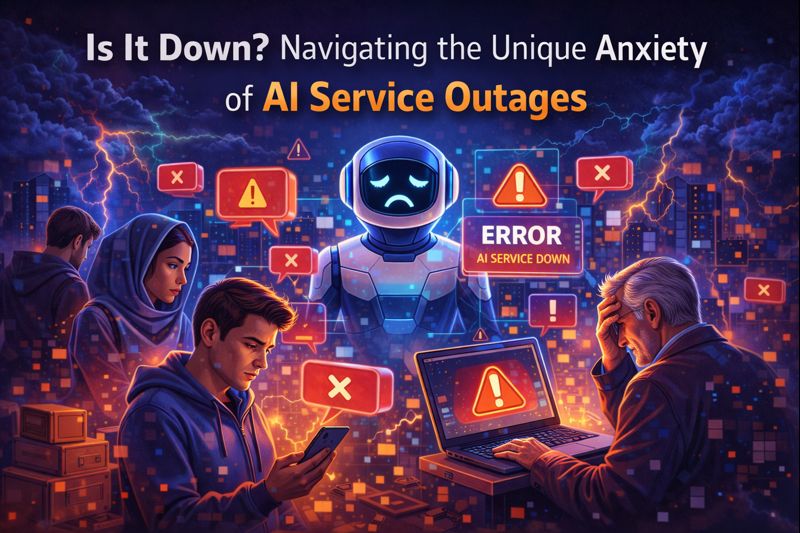The debate surrounding Character AI’s content filtering system has sparked intense discussion among users. Character AI filters are designed to monitor and limit specific content, ensuring interactions remain appropriate for diverse user demographics.
However, these restrictions can feel stifling for users seeking unrestricted communication with their AI. As a result, some users explore ways to bypass these filters, fuelling the debate about content moderation and creative freedom.
This article examines the evolution of Character AI’s filtering mechanisms, official statements on changes to their filtering policies in 2025, and user experiences, providing clarity on current filtering practices and available options for different types of conversations.
Understanding Character AI and Its Filtering System
As Character AI continues to grow, understanding its filtering system is crucial for users. Character AI is a sophisticated platform that allows users to create and interact with AI characters. The platform’s filtering system plays a vital role in maintaining a safe and respectful environment for its users.
What Is Character AI?
Character AI is an advanced AI platform that enables users to create and interact with AI-powered characters. These characters can be designed for various purposes, including entertainment, education, and companionship. The platform uses complex algorithms to generate human-like responses, making interactions feel more natural and engaging.
The Evolution of Character AI’s Content Filters
Since its inception, Character AI has implemented increasingly sophisticated content filters to maintain platform safety and comply with ethical guidelines around AI-generated content. Initially, the filtering mechanisms were basic, focusing on blocking explicit content through keyword detection. Over time, the filters have evolved to better understand context and nuance, reducing false positives while maintaining safety standards. By 2024, the platform introduced more granular filtering options, attempting to balance user freedom with responsible content moderation.
The evolution of these filters has been shaped by both technical capabilities and ongoing ethical debates about the proper boundaries for AI-generated conversations. This includes discussions around NSFW filters and the balance between creative expression and potential misuse, ensuring that the platform remains safe for a broad audience, including younger users.
The Controversy Around AI Content Filtering
The debate surrounding AI content filtering has sparked intense discussions among users and developers alike. At the heart of this controversy is the balance between creating a safe environment for users and allowing for unrestricted interactions with AI.
Why Users Want Fewer Restrictions
Some users find the current filters on Character AI restrictive, affecting their overall experience and perception of the AI’s capabilities. Critics argue that more transparent policies and greater user control over filtering levels, particularly for verified adult users, would enhance their interaction with the platform. For more information on the current state of Character AI’s filters, you can visit this page.
Safety Concerns and Platform Policies
Character AI’s platform policies prioritise creating a safe environment, with content filtering being the primary mechanism to prevent exposure to harmful content. The company maintains that unrestricted AI conversations could potentially generate content violating legal standards or ethical guidelines. A comparison of safety concerns and platform policies is summarised in the table below:
| Safety Concerns | Platform Policies |
|---|---|
| Exposure to harmful or inappropriate content | Content filtering to prevent such exposure |
| Normalisation of inappropriate behaviours | Strict filtering to prevent misuse |
| Generation of content causing psychological harm | Balancing user freedom with safety measures |
https://www.youtube.com/watch?v=3r5MGzRlvig
Did C.AI Remove the Filter in 2025?
The speculation surrounding Character AI’s filtering system in 2025 has sparked intense debate among users. While some believe that the filter was removed, others argue that there have been no significant changes.
Official Statements from Character AI
Character AI has not released an official statement confirming the removal of its filter. However, users have reported subtle shifts in the platform’s tolerance for certain topics. According to Character AI’s official communications, the platform remains committed to maintaining a safe experience for all users.
User Reports and Experiences
User reports across social media platforms and forums present mixed accounts regarding Character AI’s filtering system in 2025. Some key observations include:
- Several long-term users have documented subtle shifts in the platform’s tolerance for certain topics.
- Content creators using Character AI for storytelling have reported improvements in the system’s ability to distinguish between fictional scenarios and genuinely problematic content.
The varied user experiences suggest that any changes to the filtering system have been evolutionary rather than revolutionary, with core safety principles still in place.
How Character AI’s NSFW Filters Work
Understanding how Character AI’s NSFW filters work is essential for users who want to navigate the platform’s content policies. The NSFW filter automatically blocks conversations that involve explicit sexual language or imagery, protecting users from potentially harmful content.
Types of Content Restricted
The NSFW filter on Character AI restricts various types of content, primarily focusing on explicit sexual language or imagery. This includes text-based content that may be considered inappropriate or harmful. By limiting such content, the platform aims to maintain a respectful environment for its users.
Detection Mechanisms and Algorithms
Character AI employs a multi-layered approach to content filtering. The system begins with keyword detection, identifying potentially problematic terms and phrases in user inputs. Beyond simple word matching, the algorithms utilise contextual analysis to evaluate the surrounding conversation. This ensures that flagged words are assessed in context, reducing false positives and improving the overall effectiveness of the filters.
The platform’s filtering algorithms continuously learn from user interactions, adapting to new attempts to circumvent restrictions. This dynamic approach enables Character AI to refine its content moderation capabilities, ensuring a safer user experience.
Legal and Ethical Implications of AI Content Filtering
The debate surrounding AI content filtering raises crucial questions about the balance between freedom of expression and platform responsibility. The NSFW filter character settings on platforms like Character AI exemplify this challenge.
Freedom of Expression vs. Platform Responsibility
The user experience is significantly impacted by the filtering system in place. On one hand, a filter-free environment fosters open dialogue; on the other, it may expose users to harmful content. Striking a balance is crucial.
Regulatory Considerations in the UK and Globally
Regulatory frameworks vary globally, affecting how Character AI operates across jurisdictions. The UK’s Online Safety Bill and the EU’s Digital Services Act have introduced stringent content moderation requirements.
| Regulatory Framework | Key Requirements |
|---|---|
| UK Online Safety Bill | Robust content moderation to protect users from harmful material |
| EU Digital Services Act | Strict content moderation, influencing global filtering policies for platforms like Character AI |
Methods to Work Within Character AI’s Guidelines
To navigate Character AI’s guidelines effectively, users must adopt creative strategies that work within the platform’s content filtering system. This involves understanding the nuances of the filtering mechanism and employing techniques that allow for engaging interactions while adhering to the rules.
Creative Writing Techniques
One approach to staying within Character AI’s guidelines is to utilise creative writing techniques. By leveraging Safe For Work (SFW) alternatives and avoiding explicit language, users can convey their intended message without triggering the filters. This might involve using metaphors, symbolism, or other literary devices to add depth to the conversation. Twisting and turning words can help maintain the desired tone while keeping the content within acceptable boundaries.
Using Out-of-Character (OOC) Communication
Out-of-Character (OOC) communication is a valuable technique for providing context and guidance to Character AI without triggering content filters. By using parentheses or brackets to denote OOC comments, users can explain their creative intentions and establish boundaries for the conversation. This enables users to discuss the direction of a narrative or roleplay scenario at a meta level, helping the AI understand the desired tone. Experienced users often employ OOC communication to clarify when they’re exploring fictional scenarios, reducing the likelihood of the system misinterpreting their intentions.
- Using OOC comments to guide the conversation.
- Employing parentheses or brackets to denote OOC comments.
- Clarifying creative intentions to avoid misinterpretation.
Alternative Approaches for Unrestricted AI Conversations
Several approaches have emerged to facilitate more open and engaging conversations with AI. Users are exploring different methods to achieve their desired level of interaction.
Creating Private Characters with Custom Settings
Creating a private character with custom settings allows users to tailor their AI experience. By doing so, users can configure the AI to better understand their preferences and engage in more meaningful conversations.
Roleplay Strategies for More Open Dialogue
Roleplay provides a structured framework for exploring complex scenarios while maintaining a degree of separation from direct statements that might trigger content filters. To start a productive roleplay, users can begin with general topics and gradually introduce more specific themes, guiding the conversation step by step.
- Establishing clear character backgrounds and motivations helps the AI understand the narrative purpose of the conversation.
- Character development within roleplay can address mature themes through implication and character growth.
Alternative AI Platforms with Different Content Policies
The demand for AI platforms with fewer content restrictions has led to the development of specialised alternatives. These platforms cater to users seeking more creative freedom in their interactions.
Comparing Content Restrictions Across AI Chatbots
Several alternative AI chatbots have emerged, each with its own approach to content moderation. Some platforms implement age verification systems and consent frameworks to ensure responsible engagement with mature content. This allows users to explore complex themes while maintaining a safe environment.
Platforms Designed for Creative and Mature Content
Platforms like NovelAI and Character.ai alternatives offer more nuanced filtering systems, distinguishing between mature themes and harmful content. These platforms often provide tiered access models, allowing users to choose their level of interaction. While they may have smaller user communities or less sophisticated AI models compared to mainstream platforms, they cater to users seeking more creativity and fewer limits in their AI interactions.
The Future of Content Filtering in AI Systems
The landscape of AI content moderation is on the cusp of a significant transformation. As AI technology continues to evolve, the way content is filtered and moderated is likely to change, impacting users and platforms alike.
Emerging Technologies for Smarter Content Moderation
New technologies are being developed to improve content moderation in AI systems. These advancements aim to create more sophisticated filters that can better understand context, potentially reducing false positives and negatives. This could lead to a more seamless experience for users interacting with AI platforms.
User Customisation Options on the Horizon
Future AI platforms may offer more granular user customisation options for content filtering. This could include the ability to turn NSFW filter on or off, or to enable NSFW settings tailored to individual preferences. Such options would allow adults to set their preferred boundaries, creating a more personalised experience. Industry trends suggest that nsfw settings will become more flexible, giving others more control over their interactions.
Conclusion
The question of whether Character AI removed its filter in 2025 underscores the complex interplay between user demands and platform responsibilities.
While Character AI has adjusted its filtering system over time, a complete removal appears unlikely due to legal, ethical, and practical considerations that drive content moderation policies for character AI interactions. Users seeking more flexibility can work creatively within existing guidelines or explore alternative platforms with different content policies to potentially turn NSFW filter on or adjust their nsfw settings.
As AI technology evolves, the conversation around appropriate boundaries will remain essential, involving users, developers, and regulators in shaping responsible yet innovative AI interactions, potentially allowing them to enable NSFW settings more effectively.

















